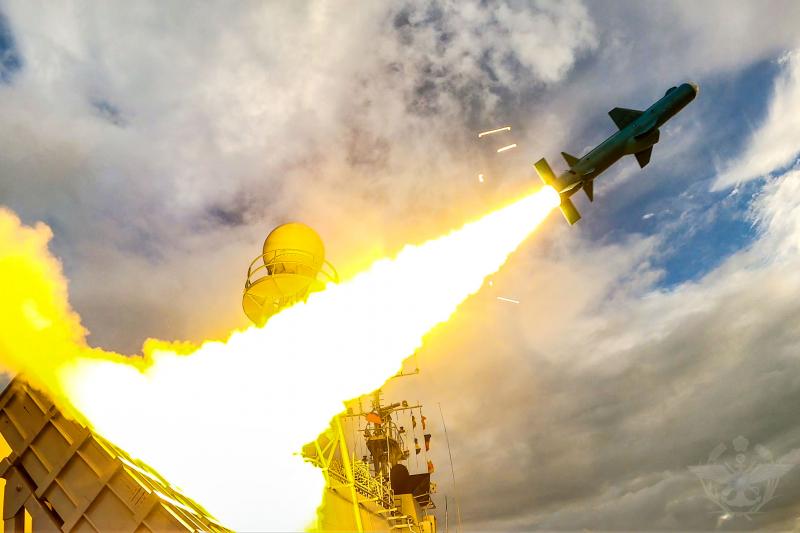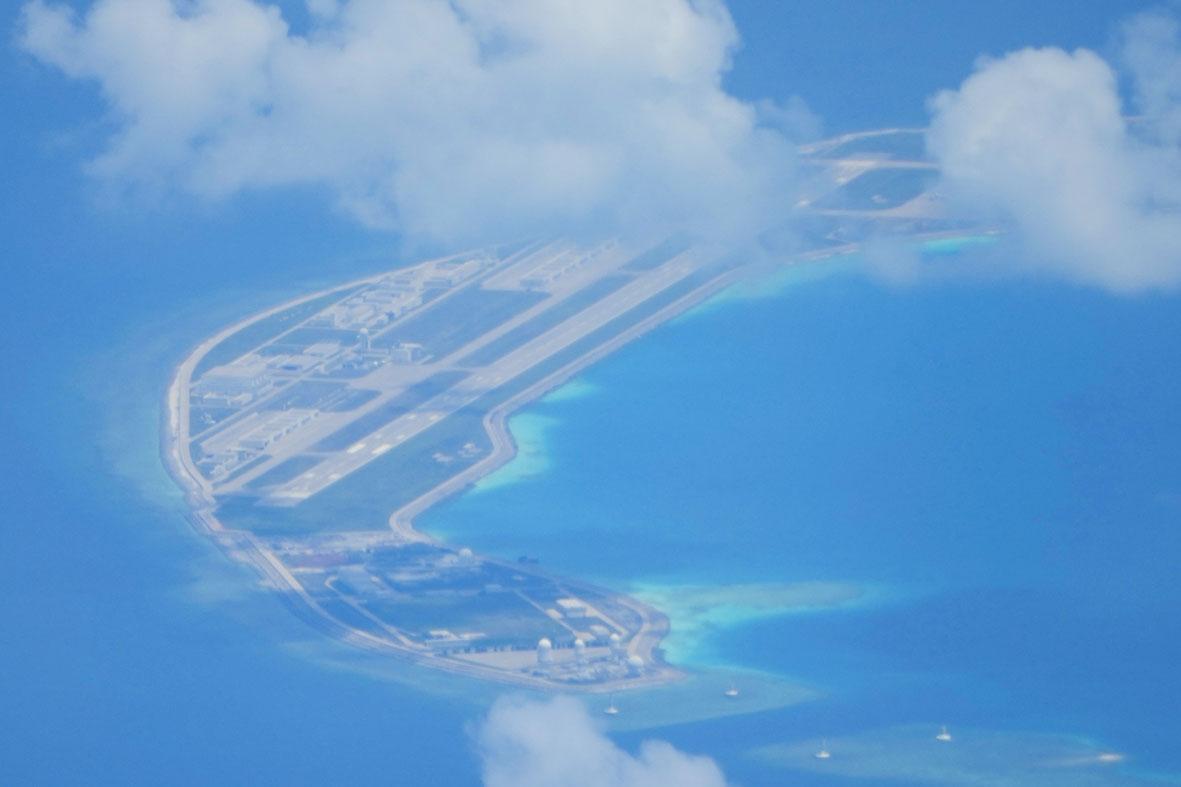This month it was revealed that China has been telling US officials that the Taiwan Strait is not an international waterway, but China’s territorial waters.
“China has sovereignty, sovereign rights and jurisdiction over the Taiwan Straits,” the Global Times thundered last week.
The slow, inexorable expansion of China’s territorial claims by land and sea signals that once Taiwan is annexed, this problem of Chinese expansionism will only become more dire. As a solid explainer from The Interpreter observed last year, China treats “territorial waters” as sovereign waters: “China’s interpretation of the territorial sea is that the state has the exclusive right to make, apply and execute its own laws in that space without foreign interference.”

Photo: EPA-EFE
POTENTIAL CONFLICTS
A glance at any of the many maps of Exclusive Economic Zones (EEZs) claimed by China shows the potential conflicts once Taiwan is obtained. To the east, a string of Japanese islands would punch holes in China’s EEZ, automatically creating further friction between those two nations.
The Japanese themselves are well aware of that possibility. Of the Yaeyama Islands, Yonaguni island is closest to Taiwan. It has its own language, Dunan Munui, and boasts a long history of links to Taiwan (killed when the US shut down black market links early in the postwar era). Currently Japanese, it was once part of the Ryukyu Kingdom’s trading networks.

Photo: AP
In the 19th century, Japan actually offered the Yaeyama islands to the Qing Dynasty as part of a trade deal for access to China’s interior. That fell through and Tokyo eventually solidified its control over them.
It is easy to see, though, how China could turn that past into a set of claims to the islands. The Chinese already see Okinawa and Taiwan as theirs, and the Yaeyama have links to both. Beyond them are the Miyako Islands, again with historical links to Okinawa.
North of Taiwan, the EEZ would encompass the Diaoyutai Islands (釣魚台), known as the Senkaku Islands in Japan, to which both the People’s Republic of China (PRC) and the Republic of China (ROC) invented claims when the possibility of oil in the area was announced in the late 1960s. A glance at the map shows obvious progression in Chinese claims from there to the Yaeyama. In Chinese propaganda, all these claims would be mutually reinforcing.
Once the Chinese gain control of Taiwan, their claims to various territories of the Philippines would automatically intensify. When it doesn’t invent history outright, Beijing loves to data-mine it: witness the way it abuses the third century Book of Wu (吳書) in the Records of the Three Kingdoms (三國志) to claim that the trip to find Yizhou (夷洲) was, absurdly, a trip to Taiwan.
Consider the history of the Batanes Islands between Taiwan and the Philippines. It is very possible to construct a history in which they belong to Taiwan. For example, a piece in the Taipei Times, dated Sept 23, 2004, “Bashi Strait: a lesson in geography” by Chen Hurng-yu (陳鴻瑜), asserts that Spanish, Japanese and Americans never really did nail down who the Batanes belonged to, and the Americans brought them into the Philippines by the simple act of occupying them in January of 1900. Taiwan, Chen appears to think, could have a claim to them.
The key point is not whether such a claim is rational, but that it could easily be magicked into existence, reinforced by the ancient cultural links between the peoples of Orchid Island and the Batanes.
Indeed, one of the dashes of the infamous (9-, 10-, 11-) dash line goes through the Bashi Channel between Taiwan and the Philippines just north of the islands. A few years ago China proposed constructing a “smart city” on Fugu Island off Luzon, in the Bashi Strait. The Chinese are obviously thinking about how to stake a claim to the area.
In the Paracels, China has already established its future interpretation of islands and the areas they control. It treats the waters between the Paracels as internal waters and draws baselines for its EEZ based on that principle, and is planning to do this for the Spratlys once it has the military ability to do so, according to China expert Oriana Skylar Mastro.
Already China implements an annual three-day fishing “ban” in the South China Sea as a way to assert its sovereign control over those waters. Its own boats with licenses can ignore the “ban,” as do the Philippines and Vietnam. But at some point these symbolic gestures will be backed by military force and by its maritime militia, its armed fishing boats and large, well-armed Coast Guard cutters. Then they will become real.
Imagine that applying to all the waters between Okinawa and Taiwan, or between Taiwan and the Philippines. Imagine too how Chinese fishing boats will eliminate Taiwanese fishing boats once China has Taiwan.
ILLEGAL FISHING
It should be noted that the opposite is not true: Chinese fishing fleets are famed for illegal fishing in other nations’ waters. In 2016 a Chinese fishing boat sank a South Korean coast guard cutter in South Korean waters. On several occasions Chinese coast guard cutters and Indonesian coast guard vessels have confronted each other in the Natuna Islands (納土納), whose waters are claimed by China as “traditional fishing grounds.”
Similarly, in violation of international sanctions, Chinese boats fish in North Korean waters, driving North Korean fishermen to desperation. Every year scores of North Korean fishing boats wash up in Japan and Russia carrying the bodies of men who have died of starvation and exposure, thanks to the Chinese fishing fleet occupying their fishing grounds.
A China in control of Taiwan will be a China further expanding illegally and violently into Pacific fishing grounds.
Multiply all these conflicting, overlapping claims, the ambiguities of 19th century colonial history and the claims it generated, and the growing power of China and its complete lack of regard for either international law or the territorial integrity of other nations. Add Chinese control of Taiwan to that witch’s brew.
The state of a future in which Taiwan is annexed to China is obvious — constant low intensity conflicts, flaring up into wars, everywhere along the expanding periphery of China’s claims.
People who think that they can resolve the “Taiwan issue” by giving the nation to China are asking for a future of constant warfare in Asia.
That the existing Chinese claims to Okinawa and the Diaoyutai/Senkaku will almost certainly lead to further conflict is something many of us have commented on. But few commentators have envisioned how annexing Taiwan will lead to further conflict via its inflated claims, especially in conjunction with its global fishing behavior.
Want peace? Keep Taiwan free.
Notes from Central Taiwan is a column written by long-term resident Michael Turton, who provides incisive commentary informed by three decades of living in and writing about his adoptive country. The views expressed here are his own.

The Taipei Times last week reported that the rising share of seniors in the population is reshaping the nation’s housing markets. According to data from the Ministry of the Interior, about 850,000 residences were occupied by elderly people in the first quarter, including 655,000 that housed only one resident. H&B Realty chief researcher Jessica Hsu (徐佳馨), quoted in the article, said that there is rising demand for elderly-friendly housing, including units with elevators, barrier-free layouts and proximity to healthcare services. Hsu and others cited in the article highlighted the changing family residential dynamics, as children no longer live with parents,

It is jarring how differently Taiwan’s politics is portrayed in the international press compared to the local Chinese-language press. Viewed from abroad, Taiwan is seen as a geopolitical hotspot, or “The Most Dangerous Place on Earth,” as the Economist once blazoned across their cover. Meanwhile, tasked with facing down those existential threats, Taiwan’s leaders are dying their hair pink. These include former president Tsai Ing-wen (蔡英文), Vice President Hsiao Bi-khim (蕭美琴) and Kaohsiung Mayor Chen Chi-mai (陳其邁), among others. They are demonstrating what big fans they are of South Korean K-pop sensations Blackpink ahead of their concerts this weekend in Kaohsiung.

Taiwan is one of the world’s greatest per-capita consumers of seafood. Whereas the average human is thought to eat around 20kg of seafood per year, each Taiwanese gets through 27kg to 35kg of ocean delicacies annually, depending on which source you find most credible. Given the ubiquity of dishes like oyster omelet (蚵仔煎) and milkfish soup (虱目魚湯), the higher estimate may well be correct. By global standards, let alone local consumption patterns, I’m not much of a seafood fan. It’s not just a matter of taste, although that’s part of it. What I’ve read about the environmental impact of the

Oct 20 to Oct 26 After a day of fighting, the Japanese Army’s Second Division was resting when a curious delegation of two Scotsmen and 19 Taiwanese approached their camp. It was Oct. 20, 1895, and the troops had reached Taiye Village (太爺庄) in today’s Hunei District (湖內), Kaohsiung, just 10km away from their final target of Tainan. Led by Presbyterian missionaries Thomas Barclay and Duncan Ferguson, the group informed the Japanese that resistance leader Liu Yung-fu (劉永福) had fled to China the previous night, leaving his Black Flag Army fighters behind and the city in chaos. On behalf of the